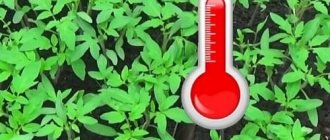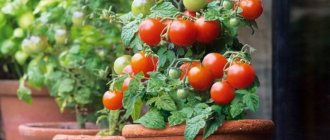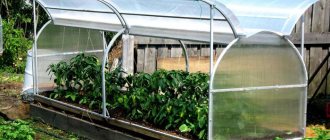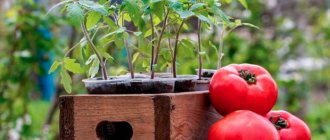Store-bought tomatoes cannot compare in taste to your own, grown on your own plot. And when they are still sweet and large, the joy from the harvest increases even more. Then how to grow tomatoes so that they later grow large and sweet? In this article I will reveal some of the secrets of proper care for tomatoes, which are sometimes neglected or simply do not know how to do it.
Difficulties and features of growing large tomatoes
Achieving a good harvest of tomatoes weighing more than 300 grams is very difficult. To succeed, it is important to consider some features :
- In central Russia, large tomatoes in open ground will not have time to ripen, so they need to be planted only in greenhouse conditions. In the south of the country, this crop can also be planted in an open area (read about growing tomatoes in open ground here);
- tomatoes need special shaping, which we will describe below;
- It will also be necessary to take care of good supports, since the fruits can break all the shoots;
- to grow such large tomatoes you will need good and long-term lighting and high air temperatures;
- such a crop is suitable for fresh use, as well as for preparing tomatoes and ketchups, but not for pickling;
- the frequency of fertilizing increases, since such tomatoes require more nutrients;
- The shelf life of such fruits is longer due to their thick peel;
- tomatoes need additional protection from the wind;
- the ripening period is later compared to small-fruited varieties;
- demanding care.
Varieties
Miracle of the earth.- Alsou.
- Black elephant.
- Delicious.
- King of Siberia.
- Koenigsberg.
- The Tsar Bell.
- Nobleman.
- A great warrior.
- Bull forehead.
- The pride of Siberia.
- Pink honey
- Favorite holiday.
- Altai miracle.
- Abakan pink.
We wrote about how to choose the right varieties of tomatoes here.
Preparatory activities
The soil
The soil for planting seedlings should include the following components:
- turf or garden soil;
- peat with acidity not higher than 6.5 pH;
- coarse river sand;
- humus or compost;
- and wood ash.
All components must be taken in approximately equal quantities.
Important! It is not recommended to take garden soil from the area where tomatoes, peppers, eggplants or potatoes grew last season.
In addition to all of the above, you need to add 10 grams of urea, 30-40 grams of superphosphate and 10-15 grams of potassium fertilizer to the substrate. You can replace all this with one complex fertilizer, which will contain mostly potassium and phosphorus and a smaller amount of nitrogen.
All mixtures for growing seedlings must be disinfected. To do this, you need to keep it in an oven heated to 200 degrees for about 40-60 minutes. This procedure must be carried out a week before planting so that beneficial bacteria reappear in the substrate.
The soil for tomatoes should be light, breathable , but at the same time one that will retain moisture. To improve air circulation, you can add small amounts of sphagnum moss to the soil.
Seed preparation
Before sowing, the seeds must be soaked in a weak solution of manganese. It is best to do this in gauze so that you don’t have to fish out the seeds later. The processing time for tomato seeds is a third of an hour. After this, the seed is washed under running water and dried.- Also, for large varieties of tomatoes, it is also necessary to carry out the soaking procedure. To do this, the seeds need to be soaked for 12 hours in the following solution: stir 20 grams of wood ash in a liter of water. Again, it is better to immediately wrap the seeds in a gauze bag. After the specified time, the seed is placed in clean water for a day. The container with water should be in a warm place (approximate temperature is 24-25 degrees above zero).
- Then we move on to the hardening process. Immediately after removing the seeds from the water, they are transferred to the refrigerator for 48 hours. Periodically, the gauze bag needs to be sprayed so that it does not dry out.
After all these procedures, the seeds are immediately planted in the ground.
We invite you to watch a video about preparing tomato seeds:
Selection of capacity
Containers for planting seedlings can be very diverse. You can purchase special cassettes, seedling boxes and peat cups (we wrote about how to grow tomato seedlings in peat cups in our material). Or you can replace them with ordinary plastic cups, in which holes are made for air and water circulation.
Currently, there are many ways to grow seedlings. We invite you to read about how you can grow tomatoes in bottles, in twists, and in peat tablets.
Don't forget to feed your tomatoes
What fertilizers are needed:
- Organic. These are mullein, droppings, bio-infusions with nettles, dung, and green manure.
- Nitrogen. Improves vegetation and growth of green mass. Tomato ripening slows down.
- Phosphorus-potassium. Necessary during flowering and ripening. Use potassium sulfate 10-15 g per 1 m2, superphosphate 25-30 g per 1 m2.
- Microelements. Boron and magnesium. When the color falls off and the fruit sets are low, the bushes are irrigated with boric acid at the rate of 1 g per 1 liter.
Fertilize seedlings at 20-25 and 40-45 days.
To harvest ripe tomatoes early, treat the tomatoes with the following composition:
- 1 bucket of water;
- 16 g urea;
- 10 g superphosphate.
How to plant: diagrams and instructions
Holes for large-fruited tomatoes need to be dug to a depth of 25 centimeters.- Almost all large-sized tomatoes are grown with one stem. Therefore, the distance between the bushes in a row should be 70 centimeters, and between the rows themselves - about half a meter. Such distances will help each tomato receive enough light and nutrients.
- You need to prepare the holes for planting seedlings in advance. You need to dig them up a week in advance so that the soil has time to warm up. Fertilizer, which consists of humus and wood ash, must be placed in the dug holes. (Calculation: add a glass of ash to a bucket of humus.) Sand must be mixed into all soil, since sandy loam soils are what tomatoes prefer.
- During planting, the temperature of the entire hole should not be less than 13 degrees Celsius. In order to obtain the desired result, the soil is covered with black film. If there is no suitable film, the holes can be warmed by pouring warm water into them. You need to pour at least a bucket into each hole. In this way, the agronomist will not only warm the soil, but also create a favorable microclimate throughout the greenhouse.
- Next, the seedlings are transferred to a permanent place along with a lump of earth in which they grew before. This will make it easier for her to bear this stress.
Read more about planting tomatoes here.
Timing of planting in open ground
In the conditions of the Moscow region, tomato seedlings are planted when the threat of late frosts has passed - that is, from June 1 to June 10. If you can build at least a temporary film shelter over the plantings and open/close it in a timely manner, you can plant the seedlings about 10...15 days earlier. In other regions, disembarkation times differ. You can get more detailed information from the article “When to plant tomato seedlings in open ground.”
How to properly care?
Formation
- In order to get a high yield of large-fruited tomatoes, the bushes need to be formed into one stem, maximum two.
- The first inflorescence must be removed.
- As soon as 3-4 inflorescences have formed, the growth of the main shoot must be stopped. To do this, you need to pinch the growth point.
- There should be no more than two ovaries on each inflorescence.
- You need to leave a couple of leaves above the last brush.
- During the entire growing season, you need to get rid of stepchildren. It is best to simply break them off and do it in the morning. In this case, you need to leave the stumps 2-3 centimeters long.
If you follow these recommendations, you can get 3-4 large tomatoes from one bush . Do not forget that such bushes need additional support. And it’s better to put it in advance, and not wait until the branches break off. It is not recommended to use fishing lines or thin wires for this procedure. Because when the branches fall on them, they may get cut.
We invite you to watch a video about shaping tomatoes:
Watering
Proper soil moisture should not be so frequent, but at the same time plentiful. Tomatoes react negatively to frequent and poor watering . It is best to flood the bushes until a small swamp forms. In extreme heat, such swampiness will quickly go away and will not harm the root system.
You can’t water the bushes from above, you only need to water them at the roots. The optimal time to moisten the soil is in the evening, when the sun has almost set. And at night the tomatoes will be able to get plenty of moisture.
Typically, the frequency of watering is 1-2 times every seven days . In this case, each bush should receive at least 5 liters of water. Before the moistening procedure, the water must be left for several days and compost, manure and weeds must be added there. This manipulation will help make the water softer, similar to rain.
We invite you to watch a video about watering tomatoes:
Lighting
Speaking about tomatoes with large fruits, it should be clarified that such a crop requires a lot of light . Otherwise, the fruits will not ripen even in three months. To plant such tomatoes, you need to choose an area that is most exposed to the sun throughout the day. There should be no shadows.
Reference! And if tomatoes grow in greenhouse conditions, it is important to take care of good additional lighting. Both fluorescent lamps and special phytolamps, which are optimal for growing plants, can be suitable here.
Feeding
The first feeding should occur a week after planting tomatoes in a greenhouse or open ground. A solution containing bird droppings is suitable for this. To do this, dry litter is soaked in water for several hours in a ratio of 1:20.
The next feeding is applied after two weeks . To do this, you can use a special complex fertilizer, or you can dilute a teaspoon of nitrophoska in 5 liters of water. Water a liter under each bush.
Such fertilizing should be carried out once every two weeks until full-fledged fruits are formed.
Seedling care
- As the seedlings dry, they should be watered with water at room temperature, and the condensation that has accumulated on the glass or film should be removed;
- It is better to sprinkle the legs of plant roots with sand so that they do not get sick with “black leg”;
- When two to four leaves appear, after about two to three weeks, the seedlings are picked, that is, transplanted into separate containers, while the main root is shortened.
Plastic cups are not suitable for large-fruited tomatoes. It is better to use cut bottles, pots, etc., at least 15 cm high;
- After transplanting, the seedlings should be watered well.
Nuances and secrets of a good harvest
- In order to get a rich harvest, you need to promptly remove the lower leaves, as well as yellowed ones and those that cover the fruits and brushes.
- To make tomatoes sweet, they need to be fed with iodine. To prepare the solution, you need to take 10 liters of water and add three drops of iodine. This fertilizer is used once a season.
- Before the first fruits form, the tomatoes need to be watered with an infusion of fermented grass.
- The period from the germination of the first seedlings to their planting in a permanent place should last at least 50 days.
Growing large varieties of tomatoes is not so easy . Therefore, not every agronomist undertakes this. However, the most important thing in this matter is to follow all the rules and implement them in a timely manner. And then the vegetable grower will receive a rich harvest of large tomatoes.
Proper watering
In dry weather, it is recommended to water tomatoes at the root, either in the traditional way or by drip. Sprinkling has a negative effect on flowering, causing shedding and thereby delaying the setting and subsequent ripening of fruits. In addition, the level of air humidity increases, which can cause the appearance and spread of fungus.
During the period when the fruits already reach a diameter of 2 cm, water consumption should be increased depending on the size of the bed. From 5 to 12 liters is enough for each square.











